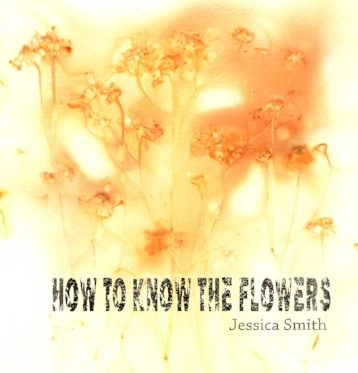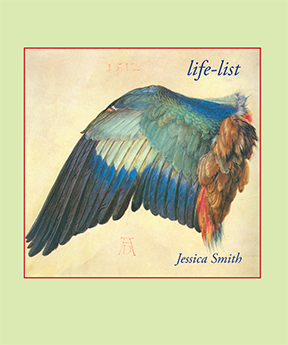Birmingham poet Jessica Smith talks about her new collection, "How to Know the Flowers."
ALINA: As the first AWC Awarded Member, I'd love to know a little about the soil that nourishes your poetry. I understand you have a new collection--and we'll get to that--but first tell us a little bit about your background, poetics, and previous collections.
JESSICA: Well, I grew up here in Birmingham and both my grandmother (dad's mom) and grandfather (mom's dad) would buy me books of collected poems and read them to me; I'm not sure why. I remember my Paw-Paw bought me a book called First Poems of Minou Drouet at the Emmet O'Neal Library book sale (he loved library book sales) and told me she was my age when she wrote the poems. Although the truth of her authorship has been debated, reading her poems was probably one of the first things that affected my "ear" for the line in poetry. I was also fed some of the usual fare: Dickinson, Frost, the Romantics. I remember, with lightning clarity, the moment I read a poem by Alice Notley in a Scholastic Reader flier in 8th grade, "After Tsang Chih" (which is in her book Grave of Light). It was about being an adolescent girl, out of place in her environment, and seeing trucks go by in her desert-landscape home. This really appealed to my teenage feeling of being stuck in Alabama and wanting something more to happen in my life.
I was already devoted to poetry as a genre by that age, but I got obsessively devoted as high school ended, and I corresponded with Robert Creeley, who led me to study at the Poetics Program at SUNY Buffalo. This program isn't a creative writing program but a deep exploration of poetry and poetics, or the aesthetic theory of poetry; there, I studied under Creeley, Charles Bernstein, and Susan Howe, who shaped what I read and how I thought about it. I think my first book, Organic Furniture Cellar (Outside Voices 2006), really reflects these influences, as does the first half of my second book, Life-List (Chax Press 2015). All of those poems were written in the early 2000s, either during or right after my time in Buffalo. The second half of Life-List was written here in Alabama, more than ten years after the first half. By that time, 2013, I had come to terms with my need to write with "feeling."
The so-called L=A=N=G=U=A=G=E poets, a loose description of a group of poets that includes Charles Bernstein and Susan Howe, are often defined by the way they use language as a material rather than as a way of expressing feelings, although this definition is easily gutted upon any close inspection of works by poets like Ron Silliman or Lyn Hejinian. But I temporarily, for a few formative years of my writing life, felt that I couldn't write poems about my feelings. Once I broke through that self-imposed mandate, I became a better poet. Or perhaps it was the process of going from an emotional poet to a clinical poet to an emotional poet that made me a better poet. The resulting books, How to Know the Flowers (Veliz Books 2019) and The Daybooks (in process), are very emotional, but are also the most sophisticated use of form and style that I have achieved so far.
ALINA:. The way you describe a softening of form to make space for new "feeling" fascinates me. I love how you describe that motion in both your style and poetrics. When I read your poems or your pedagogies, I come away with the sense that you, among so many incredible Alabama poets, are perhaps one of the MOST deliberate and intentional in probing and adapting the relationship between form and poetics. Is this intentional? How does one part speak to the other? Why or why not?
JESSICA: I started writing the way that I currently do after I went to China when I was in high school. I wanted to write poems that could be read in any direction. My current poems cannot be read in *any* direction, but they do offer multiple directions. At about the same time in my life, I discovered the experimental music of John Cage, who also played with different forms in poetry, performance, art, and music, and I started corresponding with poet Robert Creeley, with whom I later studied at SUNY Buffalo's Poetics Program. Creeley famously said that form should be an extension of content, which is related to the earlier ideas among architects and artists that "form follows function."
In the Poetics Program, I was constantly challenged to understand and explain *why* I wrote the way that I did and to read many, many books of poetics and aesthetics. The way I write hasn't changed that much, but I have a wide background in poetics, aesthetics, and philosophy to explain "how things work"-- some of this can be read in my essay "The Plasticity of Poetry.”
I have always wanted-- since that trip to China-- to open up the form for multiple readings, because not everyone physically reads the same way. I have been interested in the way the words on the page seem to open a three-dimensional space in one's mind, which has been called variously "plastic" (like sculpture), "open field," and dance-like. One of my favorite responses to my poetry was a choreographed setting of some of the poems from my second book, Life-List. Brett Mastellar composed a soundtrack, the poems were projected on the wall, and Chelsea Warren and a group of dancers danced the poems. This seemed like an entirely appropriate "reading" of the poems.
ALINA: The poems in this book are so textured and palpable. If you had to pick ten words that voyaged with you while writing this book, what would they be?
JESSICA: Thanks! I tried to use as specific words as possible, partly to continue to teach my Wilderness Literature students about the world around them. My class with them was interrupted when I was fired; before that, we were out in the woods looking at, drawing, and writing about specific plants. So the words that drove the book were botanical names: indigo, coreopsis tincturia, catalpa, tulip poplar, azalea, marigold, mulberry, blackberry, retting, mordant. In my grief and in the feverish artistic mode that followed, I was mired in the botanical stuff of Birmingham. In that micro biome where one is physically in the dirt, among the leaves, getting one's hands dirty: in that meditative space close to the earth that gardeners know. The precise vocabulary of the nature near me and of the processes of dyeing helped bring the poems closer to that mental space where one is really pulled down into the subject.
ALINA: Speaking of subjects, there’s an elephant in the pixel-room. How does Alabama enter your poetry at all? And who are your favorite nonliving poets of place? Why?
JESSICA: My poetry, in How to Know the Flowers especially, is deeply tied to Alabama and the specific land of central Alabama in spring. I write about specific species that one encounters in the Alabama outdoors. I think if you are someone who is tied to the land-- a hiker, a gardner, a farmer, an artist-- these poems will deeply resonate with what you already know.
My second book, Life-List, ranges further geographically but also takes up specific species-- in its case, birds-- in each place. I want my poetry to not only be a record of what happened and who it happened to, but of where it happened and what non-human entities were there. So it's a biological, ecological record as well as a human record.
My very favorite "poet of place" is Lorine Niedecker, who is probably also my favorite poet in general. She was from Wisconsin and lived there most of her life. Her poems mention specific species that she saw around Fort Atkinson, WI. She writes in short lines and her rhythm is often like haiku, which is a form of Japanese poetry that is often also about nature. Of her poems, "Paean to Place" might be my favorite-- it's easily found online.
ALINA: I'd love to ask you to share a link to something you've published that's available online that you would enjoy sharing. At this moment in time. And, to round it out, a song that readers could listen to while reading your published piece, providing, in a sense, two readings, or two experiences of that piece--both guided somehow by you.
JESSICA: Since I've just mentioned Life-List, I'll share a link to these poems in Tarpaulin Sky which were later published in that book. As I said, Life-List is more about birds and How to Know the Flowers is more about botany, but they're both also about interpersonal relationships and memory.
As for music-- I listen to so much music it's hard to choose. People say that poetry is "like" music, and I'm not sure what they mean. I do know that poetry doesn't always have clear melodies, as contemporary experimental classical music and improvisational jazz do not. One of the first major influences on me-- on my poetry-- was John Cage, so his "Sonatas and Interludes" might be appropriate, or a colorful long piece by Morton Feldman, or an "organic"-feeling piece by Iannis Xenakis, or a piece that borrows from birdsong by Olivier Messiaen. I'll never get over Bach, or Brahms, or P.J. Harvey or Björk. I'll go with John Cage's "In a Landscape".
ALINA: Thank you so much for being present and writing through that presence, Jessica. I encourage fellow AWC members to click on the books below, and begin the adventure of reading you. After John Cage, of course.
Jessica Smith is the author of numerous chapbooks including Trauma Mouth (Dusie 2015) and The Lover is Absent (above/ground press, 2017) and three full-length books of poetry, Organic Furniture Cellar (Outside Voices 2006), Life-List (Chax Press 2015), and How to Know the Flowers (Veliz Books 2019). She is a member of the National Book Critics Circle and teaches at the University of Alabama at Birmingham.




